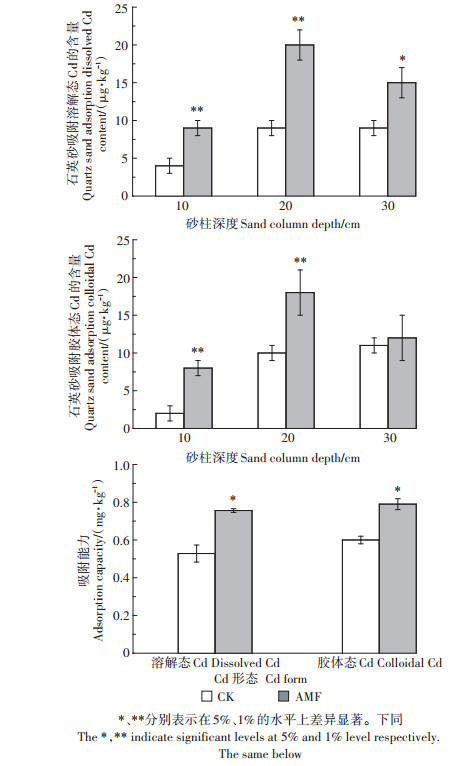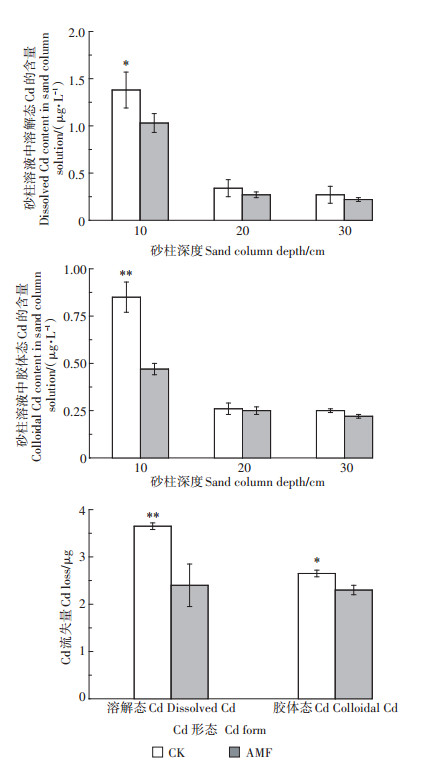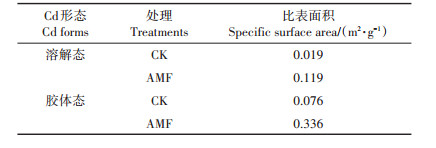2. 中国冶金地质总局昆明地质勘查院, 昆明 650203
2. Kunming Geological Exploration Institute of China Metallurgical Geology Bureau, Kunming 650203, China
采矿、施肥和污灌等活动导致我国许多农田出现不同程度的Cd污染[1]。根据《全国污染土壤调查公报》,Cd的点位超标率为7.0%,为重金属之首[2]。Cd在土壤中具有毒性、持久性和环境迁移性,在表层累积会导致土壤肥力降低和农作物减产[3-4]。由于降雨或灌溉作用造成的地表径流和淋溶,使积累在土壤表层的Cd会从上向下迁移进而造成Cd淋溶流失和污染扩散,污染深层土壤和地下水[5]。淋溶迁移的Cd主要以溶解态、胶体态和悬浮态等形式存在。溶解态Cd存在于溶液中,是吸附反应的直接来源,其中Cd2+是主要赋存形式[6],进入胶体后和胶体共迁移[7]。
Cd淋溶的影响因素很多,其中微生物对Cd的迁移就有至关重要的影响。丛枝菌根真菌(Arbuscular mycorrhizal fungi,AMF)在土壤中广泛存在,能与陆地上80%的维管植物形成共生关系[8-9]。AMF能促进植物吸收养分并减少重金属毒害,同时可改善土壤性质和减少土壤养分流失[10-12]。AMF在土壤中生长形成密集的菌丝网络,菌丝缠绕住土壤颗粒[13],且菌丝上有结合位点可以吸附固定Cd,减少Cd的流失[14];菌丝衰亡分解后会释放多糖、蛋白质等,这些有机组分被吸附后可改变土壤颗粒的表面化学性质。此外,AMF释放的球囊霉素相关土壤蛋白(Glomalin-related soil protein,GRSP)是能促进土壤胶结、提高土壤团聚体稳定性的生物胶[15],也能结合和稳定Cd离子[16],增强土壤对Cd的吸附能力[17]。Wang等[18]在对沿海周围土壤的研究中发现GRSP给重金属提供了孔隙和内表面,促进土壤吸附重金属,且GRSP固着的重金属量远远大于重金属释放量,对水质改善起着重要作用。然而,AMF对Cd淋溶的作用机制还需要深入探讨。
土壤对Cd有一定的吸附能力,但是土壤情况复杂,土壤任何性质和组分的变化都会对Cd吸附解吸和迁移有明显的影响[19],石英砂成分简单,可减少土壤中的干扰。本试验用石英砂作培养基质,添加溶解态和胶体态Cd溶液,在模拟降雨条件下研究接种AMF对Cd淋溶流失量和砂柱溶液Cd浓度的影响以及AMF菌丝对砂粒表面性质与Cd吸附-解吸特征的影响,丰富生物因素对土壤Cd淋溶流失的影响及机理方面的理论与认识。
1 材料与方法 1.1 供试材料石英砂(主要成分SiO2),粒径为0.2 mm,用2%稀硝酸浸泡后用蒸馏水洗净,在121 ℃下灭菌2 h。
玉米(Zea mays L.),品种为会单四号,种子用10%次氯酸钠(浸泡2 min)和75%乙醇(浸泡1 min)进行表面消毒后置于28 ℃恒温培养箱中催芽3 d,露白后播种。
摩西管柄囊霉(Funneliformis mosseae),由北京市农林科学院植物营养与资源研究所提供菌种(编号为BGC YN05 1511C0001BGCAM0013),经实验室扩繁后获得菌剂。
1.2 溶解态和胶体态Cd的制备溶解态Cd配制:设置Cd离子的浓度为1 mg·L-1。称取CdCl2·2.5H2O(分析纯) 10.2 mg溶于1 L蒸馏水中配制成溶解态Cd浓度为1 mg·L-1的溶液。
胶体态Cd制备:按徐伟慧等[20]的方法,制备清洁胶体储备液备用。取50 mL清洁胶体储备液和50 mL浓度为50 mg·L-1的CdCl2溶液混合,往复振荡24 h,4 000 r·min-1离心10 min,将上清液吸出,往离心管中加入50 mL蒸馏水,超声分散30 min,重新制备得胶体悬浊液,重复2次。该溶液即为试验用的胶体态Cd浓度为100 mg·L-1吸附Cd的土壤胶体溶液,试验时再稀释为1 mg·kg-1胶体态Cd溶液[21]。
1.3 砂柱制备与淋溶试验制作高30 cm、直径11 cm、顶端敞口的PVC管,在管的底部铺设尼龙布,并分别在10、20、30 cm处设砂柱溶液取样口,并安装排水龙头。石英砂灭菌后采用湿法[22]填入管中,砂柱高度30 cm。设置对照(CK)和接种AMF (AMF)两个处理,每个处理8个平行。在AMF处理砂柱表层铺2 cm的菌种,种植玉米后再覆盖3 cm的石英砂,对照则用灭菌石英砂装填。每管种植3株玉米,每隔3 d每管砂柱浇Hoagland′ s营养液100 mL和去离子水200 mL。培养30 d后,各处理取4个平行加入溶解态Cd,另外4个平行加入胶体态Cd溶液,培养7 d后用淋溶装置淋溶,每管淋溶去离子水6 L。采用Rhizons提取器收集10、20、30 cm处砂柱溶液,管底部用塑料瓶收集淋溶液。
1.4 AMF相关指标测定淋溶结束后收获玉米,测定AMF相关指标:酸性品红法测定菌根侵染率[23];按照Thapa等[24]的方法测定菌丝密度;采用湿筛-倾析法测定孢子数[25];考马斯亮蓝比色法测定球囊霉素土壤相关蛋白浓度[26]。
1.5 溶液Cd浓度测定与流失量计算砂柱溶液和淋溶液收集于塑料瓶内保存,各取25 mL采用HNO3-H2O2消解-石墨炉原子吸收光谱法测定Cd浓度。
从淋溶管底部采集的淋溶液,测量淋溶液体积和Cd浓度,由流失量=淋溶液Cd浓度×淋溶液体积,得出石英砂柱Cd淋溶流失量。
1.6 砂粒比表面积测定淋溶结束后收集石英砂,将石英砂风干后采用BET法测定石英砂的比表面积[27]。
1.7 砂粒吸附量与吸附能力测定砂粒吸附量测定:称取1 g砂柱各层的样品于50 mL塑料离心管中,加入0.1 mol·L-1的NaNO3溶液25 mL,解吸2 h,在恒温振荡箱(25 ℃)中于180 r·min-1的速度高速振荡2 h后,恒温静置过夜,4 000 r·min-1的速度高速离心10 min,取上清液过滤,用原子吸收光谱法测定金属离子Cd的浓度即石英砂吸附量。平衡时单位石英砂解吸溶液中重金属的量计算式为:

|
式中:Qd为解吸平衡时单位石英砂解吸的溶液中重金属的量,mg·g-1;Cd为解吸平衡时溶液的重金属离子的质量浓度,mg·L-1;V为解吸溶液的体积,L;m为石英砂烘干质量,g。
砂粒吸附能力测定:称取石英砂和含AMF石英砂1 g于50 mL的离心管中,加入1 mg·L-1的Cd2+溶液,置于恒温(25 ℃)振荡箱中以180 r·min-1速度离心振荡2 h,静置过夜,再以4 000 r·min-1的速度高速离心10 min,取上清液过滤,用石墨炉测定Cd2+,每个处理3次重复[27]。用差减法计算石英砂对Cd2+的吸附量,即砂粒的吸附能力。
1.8 数据处理与统计分析试验数据采用Excel整理,采用OriginPro 8进行图表绘制。采用SPSS 23.0对数据进行统计分析和整理,独立样本使用T检验进行显著性分析,并对各数据进行Pearson相关性分析。
2 结果与分析 2.1 AMF生长指标与砂粒比表面积如表 1所示,接种AMF处理玉米根系的AM真菌侵染率为30%左右,菌丝密度为30 cm·g-1左右,孢子数为12个·g-1左右,添加Cd的形态对此没有影响。石英砂的比表面积见表 2,在添加溶解态Cd条件下,对照为0.019 m2·g-1,接种处理为0.119 m2·g-1;在添加胶体态Cd条件下,对照为0.076 m2·g-1,接种处理为0.336 m2·g-1。可见,接种AMF增加了石英砂的比表面积。
|
|
表 1 AMF生长指标 Table 1 AMF growth indicator |
|
|
表 2 石英砂粒比表面积 Table 2 Specific surface area of quartz sand grains |
如图 1所示,溶解态Cd处理下,砂柱中10、20、30 cm处的GRSP含量分别为17.09、20.13、18.95 g·kg-1,胶体态Cd处理下,砂柱中10、20、30 cm处的GRSP含量分别为18.04、21.53、20.24 g · kg-1,Cd的形态对GRSP的含量无显著影响。

|
图 1 接种AMF砂柱中GRSP含量 Figure 1 GRSP content in AMF sand column |

|
图 2 石英砂对溶解态和胶体态Cd的吸附量和吸附能力 Figure 2 Sorption amount and adsorption capacity of dissolved and colloidal Cd by quartz sand |

|
图 3 砂柱溶液中溶解态和胶体态Cd浓度和流失量 Figure 3 Concentrations and loss amount of dissolved and colloidal Cd in sand column solution |
添加溶解态Cd,接种处理在10、20 cm处极显著增加石英砂的Cd吸附量,均增加了55%;在30 cm处吸附量显著增加40%。添加胶体态Cd,接种处理在10、20 cm处极显著增加石英砂的Cd吸附量,分别增加了75%和44%;在30 cm处吸附量增加不显著。由此可知,接种AMF能增强石英砂对Cd的吸附能力。总体来看,石英砂对溶解态Cd的吸附能力为0.528 mg·kg-1,接种AMF可提高至0.756 mg·kg-1,增幅为30%;石英砂对胶体态Cd的吸附能力为0.600 mg· kg-1,接种AMF可提高至0.790 mg·kg-1,增幅为24%。接种AMF后石英砂的吸附量随砂柱深度呈先增后减的趋势,在20 cm处吸附量最大。
2.4 砂柱溶液Cd浓度和流失量添加溶解态Cd,接种AMF处理10 cm处砂柱溶液的Cd浓度显著减少了25%;添加胶体态Cd,接种AMF处理10 cm处砂柱溶液Cd浓度极显著减少了45%。由此可知,接种AMF能显著降低砂柱表层溶液中的Cd浓度。从流失量来看,胶体态Cd小于溶解态Cd。其中,添加溶解态Cd条件下接种AMF处理Cd的流失量极显著降低35%,添加胶体态Cd条件下接种AMF处理Cd的流失量显著降低13%。
2.5 相关性分析相关分析表明,AMF接种情形下,砂柱3个深度的GRSP含量与砂粒Cd吸附量(r=0.685,P < 0.05,n= 24)呈显著正相关,与砂柱溶液Cd浓度(r=-0.434,P < 0.05,n=24)呈显著负相关;且砂粒Cd吸附量与砂柱溶液Cd浓度(r=-0.407,P < 0.05,n=24)呈显著负相关。
如表 3所示,在接种AMF处理下,砂柱20 cm深度的砂粒Cd吸附量与Cd流失量呈显著负相关,砂柱30 cm深度的溶液Cd浓度与Cd流失量呈显著正相关。表明接种AMF增加砂粒对Cd的吸附,有助于降低砂柱溶液Cd浓度和Cd的淋溶流失。
|
|
表 3 砂柱Cd流失量与砂粒Cd吸附量、溶液Cd浓度的相关性分析 Table 3 Correlation analysis of Cd loss in sand column with Cd adsorption of sand particles and concentration of solution Cd |
试验通过接种AMF增大石英砂吸附量,降低砂柱溶液中Cd浓度,减少Cd的流失量。AMF因减少土壤养分流失的生态功能而备受关注,AMF的菌丝网络吸收土壤养分并传输给寄主植物,使得土壤在高降雨强度下减少了40%的氮流失和50%磷流失[28]。Heijden等[29]对3种植物进行AMF的接种,结果发现无论种植哪一种植物,AMF都降低了渗滤液的体积。He等[30]研究强降雨下AMF对Cd淋溶的影响发现AMF使Cd污染土壤中T-GRSP含量和大团聚体比例增加,降低了Cd污染土壤中Cd的回流和淋滤浓度,与本试验中接种AMF减少Cd的浓度和流失量的研究结果一致。此外菌丝上的结合位点将Cd吸附固定在植物的根部[31],也能减少Cd在溶液中的浓度。本试验相关性分析中,接种AMF处理中砂柱20 cm深度的砂粒Cd吸附量与Cd流失量呈显著负相关,砂柱30 cm深度的溶液Cd浓度与Cd流失量呈显著正相关。由此可见,AMF有降低Cd淋溶流失的能力。
有研究表明,AMF的分泌物有吸附Cd的作用,从而降低溶液中的Cd浓度。GRSP由专性生物营养型AMF的活菌丝产生[32],具有胶状、非水溶性和高比表面积的特性,GRSP黏合土壤颗粒,增加土壤中的微孔量使土壤的表面积增大[18, 33],这可能是石英砂比表面积增大的原因,AMF对土壤理化性质的影响已被大量报道,但对石英砂比表面积等物理性质影响的相关报道目前较少,需要大量试验验证。本试验相关性分析表明,砂柱中GRSP含量与砂粒Cd吸附量呈显著正相关,与砂柱溶液Cd浓度呈显著正相关,说明了GRSP可能增大石英砂吸附量,降低砂柱溶液中的Cd浓度,从而减少Cd的流失。Wang等[18]用GRSP去除水中的Cd、Cu试验中发现,GRSP能有效吸附76%的Cd和95%的Cu,证实了GRSP对Cd的吸附作用。GRSP吸附土壤中重金属主要是因为GRSP上的羰基、羧基、羟基与重金属有很高的配位性[34],Cd与这些官能团形成配体后沉积在土壤中,降低了溶液中Cd浓度[35],也有学者发现GRSP上基团也能吸附土壤中的一些阳离子,和土壤中的重金属形成竞争关系,影响GRSP对Cd的吸附[36]。此外,AMF能分泌低分子量有机酸(LMWOAs),促进重金属的螯合和吸附,在土壤重金属的固定中发挥着重要作用[37]。综上所述,AMF分泌的GRSP对Cd淋溶流失的减少有一定的贡献,但AMF分泌物对重金属吸附的机理还不完善,应做深入研究。
不同形态Cd的迁移能力不一样。本试验中胶体态Cd的流失量比溶解态Cd的流失量小,主要原因是胶体态Cd是土壤胶体吸附Cd2+,胶体的高表面积和反应活性使其能够吸附重金属,同时胶体通过在基质毛细管中的阻滞作用和在大孔壁上的共沉积作用,阻碍Cd在砂柱中的迁移[38-39];但也有学者认为胶体的存在会促进Cd迁移[40]。不同形态Cd处理下,AMF也会有不同的反应机制。在溶解态Cd处理下,Cd2+优先与带负电荷的菌丝和根表面成分结合,AMF菌丝的分泌物将溶解态Cd由离子态向残渣态转变,并沉淀在砂柱中[36-37];关于AMF富集胶体态Cd的报道较少,但有学者发现AMF会释放羧酸溶解碳酸盐岩和氧化物结合的重金属,从较难溶解的形态中溶解重金属[41]。有的微生物对溶解态Cd的富集能力比胶体态Cd强,因为与胶体结合的Cd不能被微生物充分捕捉[42]。AMF对不同形态Cd响应机制还要深入研究。
4 结论(1) 接种AMF能增大石英砂比表面积,增加石英砂对Cd的吸附能力,减少砂柱溶液中Cd浓度,降低Cd的淋溶流失量。
(2) 不同形态的Cd对AMF的生长和GRSP的含量没有明显的影响,但试验中胶体态Cd的流失量小于溶解态Cd的流失量。
(3) 接种AMF砂柱中GRSP浓度与石英砂Cd吸附量呈显著正相关,与砂柱溶液Cd浓度呈显著负相关,石英砂Cd吸附量与砂柱溶液Cd浓度呈显著负相关;且砂柱20 cm处的砂粒Cd吸附量与Cd流失量呈显著负相关,30 cm处的溶液Cd浓度与Cd流失量呈显著正相关。综上所述AMF菌丝及其分泌的GRSP对减少Cd的淋溶流失有一定的贡献。
| [1] |
Jing F, Chen X, Yang Z, et al. Heavy metals status, transport mechanisms, sources, and factors affecting their mobility in Chinese agricultural soils[J]. Environmental Earth Sciences, 2018, 77(3): 104-113. |
| [2] |
陈能场, 郑煜基, 何晓峰, 等. 《全国土壤污染状况调查公报》探析[J]. 农业环境科学学报, 2017, 36(9): 1689-1692. CHEN Neng-chang, ZHENG Yu-ji, HE Xiao-feng, et al. Analysis of the Report on the National General Survey of soil Contamination[J]. Journal of Agro-Environment Science, 2017, 36(9): 1689-1692. |
| [3] |
汪宜敏, 唐豆豆, 张晓辉, 等. 玉米秸秆炭对红壤镉吸附及养分含量、赋存形态的影响[J]. 农业环境科学学报, 2017, 36(12): 2445-2452. WANG Yi-min, TANG Dou-dou, ZHANG Xiao-hui, et al. Effects of corn-straw biochar on cadmium adsorption, nutrient contents, and chemical forms in red soil[J]. Journal of Agro-Environment Science, 2017, 36(12): 2445-2452. |
| [4] |
刘意章, 肖唐付, 熊燕, 等. 西南高镉地质背景区农田土壤与农作物的重金属富集特征[J]. 环境科学, 2019, 40(6): 2877-2884. LIU Yi-zhang, XIAO Tang-fu, XIONG Yan, et al. Accumulation of heavy metals in agricultural soils and crops from an area with a high geochemical background of cadmium, Southwestern China[J]. Environmental Science, 2019, 40(6): 2877-2884. |
| [5] |
Gray C W, Monaghan R M, Orchiston T, et al. Cadmium losses in overland flow from an agricultural soil[J]. Environmental Science and Pollution Research, 2017, 24(30): 24046-24053. |
| [6] |
梁美娜, 张涛, 王敦球, 等. 生物质吸附剂去除废水中镉的研究进展[J]. 桂林理工大学学报, 2017, 37(4): 676-681. LIANG Mei-na, ZHANG Tao, WANG Dun-qiu, et al. Research advances of cadmium removal from wastewater by biomass adsorbent[J]. Journal of Guilin University of Technology, 2017, 37(4): 676-681. |
| [7] |
杨悦锁, 王园园, 宋晓明, 等. 土壤和地下水环境中胶体与污染物共迁移研究进展[J]. 化工学报, 2017, 68(1): 23-36. YANG Yue-suo, WANG Yuan-yuan, SONG Xiao-ming, et al. Cotransport of colloids and facilitated contaminants in subsurface environment[J]. Journal of Chemical Industry and Engineering, 2017, 68(1): 23-36. |
| [8] |
Maclean A M, Bravo A, Harrison M J, et al. Plant signaling and metabolic pathways enabling arbuscular mycorrhizal symbiosis[J]. The Plant Cell, 2017, 29(10): 2319-2335. |
| [9] |
Bach E M, Narvaez-Rivera G, Murray K, et al. The dynamic life of arbuscular mycorrhizal fungal symbionts[J]. Ecology, 2018, 99(4): 1-3. |
| [10] |
Zhang X, Hu Z, Yan T, et al. Arbuscular mycorrhizal fungi alleviate Cd phytotoxicity by altering Cd subcellular distribution and chemical forms in Zea mays[J]. Ecotoxicology and Environmental Safety, 2019, 171: 352-360. |
| [11] |
Parihar M, Meena V S, Mishra P K, et al. Arbuscular mycorrhiza:A viable strategy for soil nutrient loss reduction[J]. Archives of Microbiology, 2019, 201: 723-735. |
| [12] |
Zhan F D, Li B, Jiang M, et al. Effects of arbuscular mycorrhizal fungi on the growth and heavy metal accumulation of bermudagrass[Cynodon dactylon(L.)Pers.] grown in a lead-zinc mine wasteland[J]. International Journal of Phytoremediation, 2019, 21(9): 849-856. |
| [13] |
Janoušková M, Pavlíková D. Cadmium immobilization in the rhizosphere of arbuscular mycorrhizal plants by the fungal extraradical mycelium[J]. Plant and Soil, 2010, 332: 511-520. |
| [14] |
祖艳群, 卢鑫, 湛方栋, 等. 丛枝菌根真菌在土壤重金属污染植物修复中的作用及机理研究进展[J]. 植物生理学报, 2015, 51(10): 1538-1548. ZU Yan-qun, LU Xin, ZHAN Fang-dong, et al. A review on roles and mechanisms of arbuscular mycorrhizal fungi in phytoremediation of heavy metals-polluted soils[J]. Plant Physiology Communications, 2015, 51(10): 1538-1548. |
| [15] |
Zhang Z, Mallik A, Zhang J, et al. Effects of arbuscular mycorrhizal fungi on inoculated seedling growth and rhizosphere soil aggregates[J]. Soil and Tillage Research, 2019, 185: 1-8. |
| [16] |
Jia X, Zhao Y, Liu T, et al. Elevated CO2 increases glomalin-related soil protein(GRSP) in the rhizosphere of Robinia pseudoacacia L. seedlings in Pb- and Cd-contaminated soils[J]. Environmental Pollution, 2016, 218: 349-357. |
| [17] |
王建, 周紫燕, 凌婉婷. 球囊霉素相关土壤蛋白的分布及环境功能研究进展[J]. 应用生态学报, 2016, 27(2): 634-642. WANG Jian, ZHOU Zi-yan, LING Wan-ting. Distribution and environmental function of glomalin-related soil protein:A review[J]. Chinese Journal of Applied Ecology, 2016, 27(2): 634-642. |
| [18] |
Wang Q, Mei D G, Chen J Y, et al. Sequestration of heavy metal by glomalin-related soil protein:Implication for water quality improvement in mangrove wetlands[J]. Water Research, 2019, 148: 142-152. |
| [19] |
杨晓丹, 冯一舰. 多类型土壤对Cd、Pb、Cr的吸附特征及其垂向迁移规律研究[J]. 广东化工, 2018, 45(11): 92-96. YANG Xiao-dan, FENG Yi-jian. Study on the characteristics of adsorption and vertical migration of Cd, Pb and Cr in different type[J]. Guangdong Chemical Industry, 2018, 45(11): 92-96. |
| [20] |
徐伟慧, 胡影, 王志刚. DEP和DBP在黑土胶体微界面的动力学行为[J]. 生态环境学报, 2018, 27(4): 752-760. XU Wei-hui, HU Ying, WANG Zhi-gang. Dynamic behavior of DEP and DBP developing on the interface of black soil colloid[J]. Ecology and Environment Sciences, 2018, 27(4): 752-760. |
| [21] |
Sun H, Gao B, Tian Y, et al. Kaolinite and lead in saturated porous media:Facilitated and impeded transport[J]. Journal of Environmental Engineering, 2010, 136(11): 1305-1308. |
| [22] |
Fountouli T V, Chrysikopoulos C V, Tsanis I K. Effect of salinity on formaldehyde interaction with quartz sand and kaolinite colloid particles:Batch and column experiments[J]. Environmental Earth Sciences, 2019, 78(5): 152. |
| [23] |
Li J, Liang H, Yan M, et al. Arbuscular mycorrhiza fungi facilitate rapid adaptation of Elsholtzia splendens to copper[J]. Science of the Total Environment, 2017, 599/600: 1462-1468. |
| [24] |
Thapa T, Kumar De U, Chakraborty B. Association and root colonization of some medicinal plants with arbuscular mycorrhizal fungi[J]. Journal of Medicinal Plants Research, 2015, 3(2): 25-35. |
| [25] |
毕银丽, 吴王燕. 染色法——一种改进的丛枝菌根孢子密度快速测定方法[J]. 能源环境保护, 2007, 21(2): 9-11. BI Yin-li, WU Wang-yan. Dyeing method:A kind of the method for mycorrhizal spore density quick improved measurement[J]. Energy Environmental Protection, 2007, 21(2): 9-11. |
| [26] |
张静, 唐旭利, 郑克举, 等. 赤红壤地区森林土壤球囊霉素相关蛋白测定方法[J]. 生态学杂志, 2014, 33(1): 249-258. ZHANG Jing, TANG Xu-li, ZHENG Ke-ju, et al. An improved procedure for glomalin-related soil protein measurement in subtropical forest[J]. Chinese Journal of Ecology, 2014, 33(1): 249-258. |
| [27] |
曾冬萍, 颜远烽, 林芳, 等. 重金属钝化修复剂对镉和铅吸附及解吸特征的影响研究[J]. 实验技术与管理, 2015, 32(9): 54-58. ZENG Dong-ping, YAN Yuan-feng, LIN Fang, et al. Effects of heavy metal passivation repairing agent on cadmium, lead adsorption and desorption characteristics[J]. Experimental Technology and Management, 2015, 32(9): 54-58. |
| [28] |
Martínez-García L B, Deyn G B, Pugnaire F I, et al. Symbiotic soil fungi enhance ecosystem resilience to climate change[J]. Global Change Biology, 2017, 23(12): 5228-5236. |
| [29] |
Heijden M G A V. Mycorrhizal fungi reduce nutrient loss from model grassland ecosystems[J]. Ecology, 2010, 91(4): 1163-1171. |
| [30] |
He Y M, Yang R, Lei G, et al. Arbuscular mycorrhizal fungi reduce cadmium leaching from polluted soils under simulated heavy rainfall[J]. Environmental Pollution. DOI:10.1016/j.envpol.2020.114406 |
| [31] |
Zhan F D, Li B, Jiang M, et al. Arbuscular mycorrhizal fungi enhance antioxidant defense in the leaves and the retention of heavy metals in the roots of maize[J]. Environmental Science and Pollution Research, 2018, 25(24): 24338-24347. |
| [32] |
Yang Y R, He C J, Huang L, et al. The effects of arbuscular mycorrhizal fungi on glomalin-related soil protein distribution, aggregate stability and their relationships with soil properties at different soil depths in lead-zinc contaminated area[J]. PLoS One, 2017, 12(8): e0182264. |
| [33] |
Eusterhues K, Rumpel C, Kögel-Knabner I, et al. Organo-mineral associations in acid forest soils:Importance of specific surface area, iron oxides and micropores[J]. European Journal of Soil Science, 2010, 56(6): 753-763. |
| [34] |
Wang Q, Chen J, Chen S, et al. Terrestrial-derived soil protein in coastal water:Metal sequestration mechanism and ecological function[J]. Journal of Hazardous Materials, 2019, 386: 121655. |
| [35] |
Ban Y, Xu Z, Zhang H, et al. Soil chemistry properties, translocation of heavy metals, and mycorrhizal fungi associated with six plant species growing on lead-zinc mine tailings[J]. Annals of Microbiology, 2015, 65(1): 503-515. |
| [36] |
González-Chávez M C, González R C, Wright S F, et al. The role of glomalin, a protein produced by arbuscular mycorrhizal fungi, in sequestering potentially toxic elements[J]. Environmental Pollution, 2004, 130(3): 317-323. |
| [37] |
沈美红, 龚玉莲, 陈彩锋, 等. 根系分泌物对土壤重金属吸附解吸影响的研究进展[J]. 绿色科技, 2019(6): 81-83, 86. SHEN Mei-hong, GONG Yu-lian, CHEN Cai-feng, et al. Advances in studies on the effects of root exudates on adsorption and desorption of heavy metals in soil[J]. Journal of Green Science and Technology, 2019(6): 81-83, 86. |
| [38] |
Liu G, Xue W, Wang J, et al. Transport behavior of variable charge soil particle size fractions and their influence on cadmium transport in saturated porous media[J]. Geoderma, 2019, 337: 945-995. |
| [39] |
Li Z, Zhou L. Cadmium transport mediated by soil colloid and dissolved organic matter:A field study[J]. Journal of Environmental Sciences, 2010, 22(1): 106-115. |
| [40] |
杨士, 卢陈彬, 刘祖文, 等. 土壤胶体对重金属迁移及生物有效性影响的研究进展[J]. 环境污染与防治, 2019, 41(8): 974-978. YANG Shi, LU Chen-bin, LIU Zu-wen, et al. Advances of the effects of soil colloids on heavy metal migration and bioavailability[J]. Environmental Pollution and Control, 2019, 41(8): 974-978. |
| [41] |
Aghababaei F, Raiesi F, Hosseinpur A, et al. The influence of earthworm and mycorrhizal co-inoculation on Cd speciation in a contaminated soil[J]. Soil Biology and Biochemistry, 2014, 78: 21-29. |
| [42] |
胡达理, 李智义, 邓晓舟, 等. 水网藻对不同粒径悬浮态镉的去除机制研究[J]. 湖南农业科学, 2018, 396(9): 59-61, 67. HU Da-li, LI Zhi-yi, DENG Xiao-zhou, et al. Removal mechanism of cadmium suspended in different particle sizes by Hydrodictyon reticulatum[J]. Hunan Agricultural Sciences, 2018, 396(9): 59-61, 67. |
 2020, Vol. 39
2020, Vol. 39





